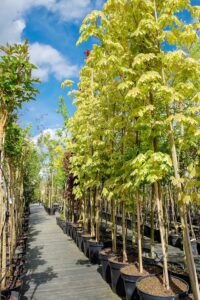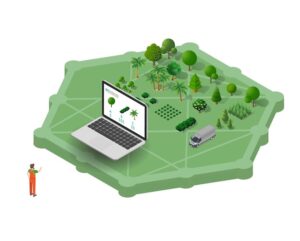Why the Green Industry Needs Supply Chain 2.0

By Marc Elliott
The recent blockage of the Suez Canal is the perfect metaphor to highlight the need for more intelligent supply chains across industries. A BBC article reported that the blockage may have cost global trade anywhere between $6 and $10 billion. The green industry is also prone to black swan events – the most recent being the Texas freeze – that can cause devastating ripple effects.
The freeze damaged hundreds of thousands of plants and trees across the state, and if early trends are anything to go by, it will also contribute to plant shortages in other states, such as Florida.
This brings us to an important question: What are the biggest causes of disruption for the green industry supply chain, and what changes can keep the green industry thriving?
Communications between suppliers, landscapers, and architects
Although unexpected disasters do play a part in derailing the supply chain, lack of adequate communication between landscapers and suppliers has been a more consistent challenge. A lot of this could be due to the way we organize our industry, and the smaller average size of operations teams. After all, an average landscaping services business has just two employees as per the latest analysis by IBIS. Smaller team sizes make it difficult to communicate vital information in time between multiple projects and stakeholders. For example, larger trees need to be dug in advance, and any uncertainty in verbal communication can lead to delayed deliveries or increase the risk of trees dying off before they get planted.
Lack of streamlined communication between landscapers and architects is often also a contributing factor to supply chain failure. From our own experience, it’s often the root cause of plant materials not matching the specs required by the landscape architect.
Bad weather conditions present yet another communication challenge, and stretch resources too thin. For example, hurricanes and stormy weather can put deliveries on hold, and create a backlog that can clash with future shipments. If any changes to the plan are not communicated in time, it can lead to installation delays.
The obvious solution to improving communication would be to strengthen operations teams across the industry, especially on the execution side of wholesale nurseries and landscape contractors. In addition, adopting project management software such as LMN or Aspire can offer excellent tools for visualizing multiple timelines to stay on top of installations.
For smaller or one-person landscaping businesses, the solution could be getting help from plant brokers or making long-term deals with local nurseries to reserve their inventory ahead of time.
Landscape planning and execution silos
Sustainability has become central to many landscaping projects, and initiatives such as “Florida Friendly” landscaping have helped.
However, when it comes to availability and “material awareness,” we often find a split between two distinct groups:
- Planners (city councils, landscape architects)
- Executors (wholesale nurseries, plant brokers, landscape contractors).
While the “planners” tend to focus on aesthetics and ecological factors, the “executors” are often more pragmatic about what is possible in the given timeline. Part of the problem could be the late involvement of material-sourcing specialists in the procurement process. The end result? Last-minute substitutions, rejection of plant materials, and added fuel consumption for transport that definitely doesn’t contribute to sustainability. Substitutions make the green industry lose millions of dollars every year due to added time that takes away from billable hours, and wastage of material that dies off in transit.
Getting planners and executors on the same page through an integrated platform could be the first step in ensuring more “execution-ready” design, while eliminating the need for substitutions later.
Longer production and maturity cycles for plant materials
No discussion on supply chain challenges can be completed without discussing the fact that product development lead times (a.k.a., growing the plant materials) is much longer for the green industry versus other industries. So, when design trends can suddenly bring a particular tree or perennial in “fashion,” it takes a while for growers to catch up with the demand. In the meantime, the industry goes through a severe shortage of that particular species. Government intervention can help bridge the gap in planning and execution and offer respite from frequent over- or under-supply cycles. For example, a few years back, Autumn Blaze maples were a staple tree for many projects throughout Canada and the northern United States. As native trees that change colors in the fall, they are certainly an excellent choice to introduce some variation in tones. Naturally, increased demand of these maples led to most nurseries filling their acres with them – only to add to the unsold inventory a few years down the line.
Timely guidance and support from governmental authorities could have eased this drastic mismatch in demand and supply.
Plant diversity and the green industry supply chain
Another reason why the green industry is more susceptible to supply chain disruptions is the lack of diversification. Since plant materials make the root and leaves of the industry, specie-wide diseases can be a huge factor. In fact, there is a fresh advisory by the Liberty Tree Board about oak wilt in Missouri. Imagine the plight of large installations that have favored the Pin Oak in the area.
Bulk plantations of the same species increase the threat of mass replacements and supply chain disruptions if a disease were to hit that species.
Another example of how diversity affects the supply chain can be the periodic fungal attacks on aspen trees. Many landscape contractors have often experienced mass rejections due to fungal infections. While these blights do not necessarily kill the trees, they do make it harder to get them approved. Diversifying the plant or tree species can help address this issue to an extent, and bring down the number of possible replacements.
Again, better communication between city councils and agricultural bodies can create a “varying quality standard” every season. Such a standard can also help tree inspectors appointed by councils make more objective decisions and reduce the ambiguity.
On that note, nurseries can also improve their own market readiness by diversifying their plants and tree inventories.
Greater diversity helps everyone in the green industry value chain.
What will supply chain 2.0 look like for the green industry
Back to Texas…the aftermath of the freeze offers an interesting insight into where the green industry is headed in terms of supply chain. Both nurseries and landscape contractors in our network have reported huge shipments getting delivered from Florida to installation sites in Texas. Let’s think for a moment what that means for competition and pricing in the local market – it will probably add to an already severe shortage of many plants and trees in Florida.
As the industry grows, we will see more cross-state supply chain collaboration, especially in states that fall in the same hardiness zones.
The lawn and landscape industry is generally considered to be slow on tech adoption; however, COVID-19 seems to have fast-tracked this process. The National Association of Landscape Professionals (NALP) has already estimated that technology and software investment will probably rise once businesses are back to somewhat pre-COVID levels. The real change would be how the industry makes decisions though. Supply chain 2.0 will need more data-driven decisions that help bring together disparate factors.
Last, but not the least, we will see the rise of more specialized aggregation services. This could address multiple issues such as consultations on sustainability and aggregation of plant knowledge, plant availability, and market insights.
No industry has escaped technology-driven aggregation. The green industry, in contrast, has so far resisted drastic changes to the supply chain. However, the combined forces of increased tech adoption, sharper focus on ecology and sustainability, and changing economic situation could flip the switch. Considering the many challenges facing landscape construction, I can’t wait for the arrival of more intelligent, and better-organized supply chain for our industry.
Marc Elliott is the CEO and co-founder of GoMaterials, an online marketplace to source plant materials for landscaping professionals. For more information, visit https://www.gomaterials.com/
Sources
https://www.parkrecord.com/news/summit-county/fungus-attacks-local-aspens/
giecdn.blob.core.windows.net/fileuploads/document/2020/10/13/29_soi%20research_october.pdf
www.lawnstarter.com/blog/statistics/latest-landscaping-industry-statistics-and-data-for-2019/





